October 9-12, 2009
The weather continued to go downhill (hah) after we left the Bear Mountain area. Cold, windy, and dreary conditions followed us south down the Hudson. I was feeling sorry for the cruisers we had spoken with that would be heading into the New York harbor area, not just because they were sailors having to be out in the lousy weather, but because the city's waterfront just doesn't look as exciting when the sun isn't shining on all the buildings. I didn't even take any Manhattan skyline photos since the skies were just so gray. As long as conditions aren't so bad to where they are literally making us sick, I try to find excitement by watching for anything of interest that may be new to us or things that will generate conversation.
Since it was early afternoon when we reached the area by the Statue of Liberty we took a short detour to a place called Liberty Landing, a small anchoring area west of the SOL. We didn't expect to be able to drop the hook back there, but many cruisers do. We followed the narrow channel all the way to the end and saw 3 small anchored sailboats. There may have been room for another boat, but we wouldn't have felt comfortable in that tight of quarters with the weather that was expected later that night. If you anchored there, here is a view you would have (Eddie was so fascinated to see Miss Liberty from her backside):
I guess we were motivated by the explorations of Henry Hudson because we made another bold move and turned into the Kill Van Kull. This river runs around the back side of Staten Island and may be considered an alternate route to get to the Atlantic Highlands area if the Lower Bay area is too rough. We haven't talked to any other cruisers that have mentioned taking this route, but we weren't in a hurry and wanted to see what it was like.
From its entrance by Bayonne all the way to Perth Amboy, the area is a marine industrial area lined with loading docks and storage areas for freighters and tankers. It also appears to be a haven where fleets of the big working tugs are stored when they are not called into action for a hook up. All three of us always enjoy seeing the activities of a working waterfront, but you have to be on alert at all times for moving behemoths in the tight quarters.
This colorful tanker caught my eye. Notice how high above the waterline the ship is sitting. We didn't know if it was getting filled up or unloaded, but I'm guessing it was unloaded since we heard the ship conversing with a tug about moving shortly after we went by, and there would have been no way the ship could have gotten filled that quickly.
Kill Van Kull turns into Arthur Kill and then it empties into Raritan Bay south of Perth Amboy. By the time we made it into the Bay, it was too late for us to go all the way over to the Atlantic Highlands, where cruisers typically anchor behind a breakwater. So, based on the weather forecast we dropped the hook on the southwest side of Raritan Bay in a sandy area off a beach west of Keyport marked on the charts as a sewer.
We had a steady night, but a front moved through by mid-morning, bringing strong winds out of the northwest. With the long fetch across the Bay, the water in our area kicked up bouncing us around too much.
Since things had gone so well with the anchorage on the south side of the Bay, rather than move all the way over to Atlantic Highlands where we suspected there would be a big crowd, we decided to just move across the Bay and anchor on the north side where we would be able to get wind and wave protection from the south side of Staten Island.
We dropped the hook in a sandy area about a mile south of Great Kills Harbor, another popular cruising anchorage. We didn't bother to go in there because we had heard it was crowded, and we felt we would be comfortable out in the open area based on the weather forecast. Plus, we knew we could easily head out to sea in the dark the following morning after the winds had shifted to make our Atlantic Ocean passage safe and comfortable.
We were anchored off a beach near a residential neighborhood with homes of varying styles to say the least. This one home caught my attention because of the row of palm trees that lined the fence around the back yard. I am assuming the palm trees are just a summer planting as they would never survive a winter in that location.
We had the engine started by 0545, and were delighted to see some clear sky when the sun rose. Seas were fairly calm and the sun stayed out enough to keep the pilothouse comfortable. It was the first day we had seen the sun since our hike up Anthony's Nose. However, another front was on its way, so we decided to stop in Atlantic City, about 2/3 thirds the distance down the New Jersey coastline.
We ran for 11.75 hours to get to Atlantic City, and there was a stream of cruising boats going into the inlet, all having tried to take advantage of that small weather window. We had never stopped here before, so we were apprehensive about how much room would be available for us to anchor, but we decided it was time to finally check it out. This was our late afternoon view coming in the inlet:
5 windmills look odd amongst all the big buildings. It is fascinating to see this alternate energy source in this location.
Many communities do wonderful jobs decorating their water towers, usually a prominent feature in the landscape, and this cute one caught my eye:
The area we were headed towards is called The Pond, and it is connected to the inlet's main channel by a deep, narrow passageway, wide enough for about 2 boats to pass. We heard inbound cruising boats talking about how to enter and pass through the channel, which was very helpful to cruisers like us who had never done it before. You have to drive almost on shore on the port side of the channel when entering; it is as though you are trying to pick up some of the marsh grass, but the deep water extends all the way to the shore.
Once you make it through the channel, the area opens up into a nice sized anchorage. With all the boats there, 15, we only put out 100' of chain, but knew we had good holding and weren't expecting real strong winds. The views around the anchorage vary from condos, single family residences, to the skyline of the casinos. One of the buildings flashes an array of rainbow colors along the entire side of the building; it is very pretty at night.
Before Atlantic City got built up as a gambling center, its inlet, easy to navigate, was important for commercial and recreational boaters and required a tall aid to navigation, a lighthouse. That lighthouse still stands, but is no longer important for navigation purposes because it is dwarfed by the huge buildings, which are always shining brightly and can be see from farther out to sea than the lighthouse ever could be. Now the lighthouse just sits amidst the buildings, looking sadly out of place.
We left Atlantic City with a poor weather forecast in regards to us being able to go outside again down the Delmarva Coast as an overnight trip; we would be forced into traveling up Delaware Bay, across the C & D Canal, and then down through Chesapeake Bay. We debated about trying to wait for a weather window behind the breakwater in Lewes, DE, but none looked in the near future that would guarantee decent sea conditions. The best part about not having to make that run was not having to cross over the intersection of Delaware Bay and the Atlantic Ocean. The water there can be quite swirly and very uncomfortable depending on the tide with the powerful influences of both the ocean and bay colliding.
The offshore run from Atlantic City to Cape May at the southern tip of New Jersey was sloppy, but not bad enough to make anyone sick. It was a day without sunshine, cold, and just plain dreary. It was a relief to be able to get out of the ocean to cut through the Cape May Canal even though we generally don't like having to go through that area. It is too congested, the fishermen drive like idiots, and there is usually shoaling somewhere and/or there is a dredge operating.
Going up Delaware Bay can be a real challenge when the winds are bad and the current is against you. Even though it was gray and windy, the winds were northeast/east and since we were traveling northwest, they didn't make for a real bumpy ride. Plus, the tide was coming in, so it was giving us a big push, frequently giving us a 2-3 KT boost to get our speed up over 10 KTS (11.5 MPH). When you're doing double digits in a trawler you feel like you're flying over the water!
The day was just so dreary, like a dismal veil was draped over the whole waterfront. Late in the day, a sailboat appeared that had a brightly colored spinnaker. It was such a stark contrast to everything around it.
Delaware Bay is the main thoroughfare for ocean going vessels traveling to/from the Chesapeake via the C & D Canal or Philadelphia. It is very important to keep an eye out for those guys since they are moving wide open on the waterway and can't quickly maneuver to avoid smaller vessels like FLUKE. We usually travel just outside the main shipping channel, and keep our radio on the commercial shipping channel While it is easy to see the big guys approaching, it is also important to keep an eye behind us since we could easily be overtaken without realizing it. This fuel tanker went by closely; look at the wave he is pushing ahead of his bulbous bow.
We made such good time heading north we were able to get all the way to the Reedy Island anchorage before dark. It was our first time stopping there and a good time to try it out with the weather we were having. Reedy Island is a small spot of land surrounded by 10-25' water close to the western shore of Delaware Bay. A shoal area extends north of the island, and a man made dike extends south. There is a marker opening (you have to pay attention to the chart and look carefully) through the dike that takes you into the deep water anchoring area. The island, shoal, and dike all help to block down the wake and wave action coming off the Bay. The island and close proximity of the west/northwest shorelines help block the wind. We got safely tucked in and dropped the hook with good holding.
The Salem nuclear power plant provided a good reference for our location during the night since it is brightly lit. It is rather a dismal looking facility even with the sun out, but I found it particularly industrial and ominous looking on the dreary day we passed by. You can easily see the 3 reactor units, and the big cooling tower looks like it is spewing all the nasty weather we are enduring.
We are keeping our fingers crossed for a change in the weather as we head down the Chesapeake Bay. (Not so far!)
Wednesday, October 14, 2009
Subscribe to:
Post Comments (Atom)
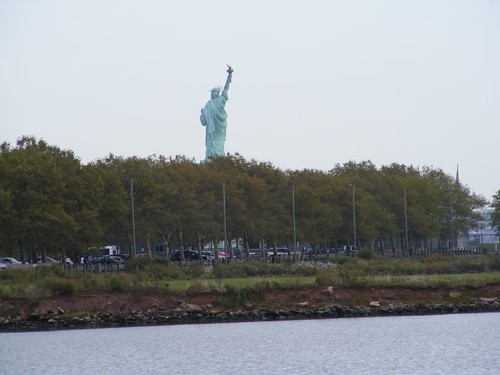
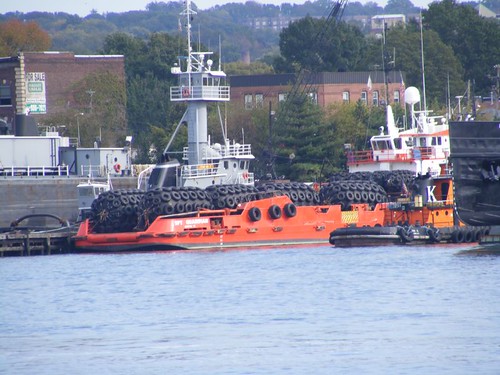
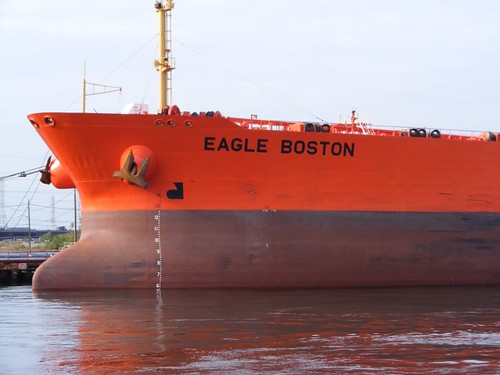
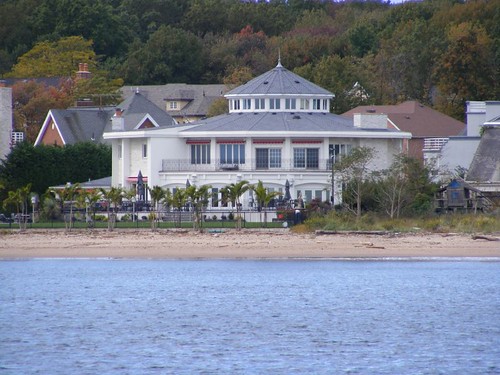
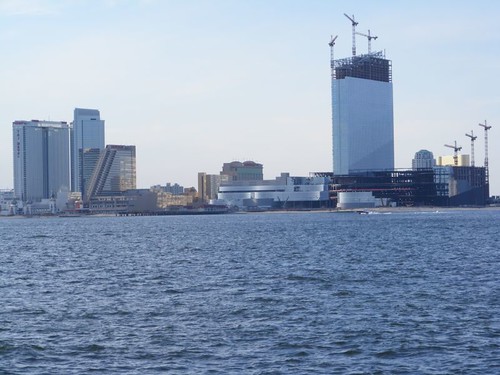
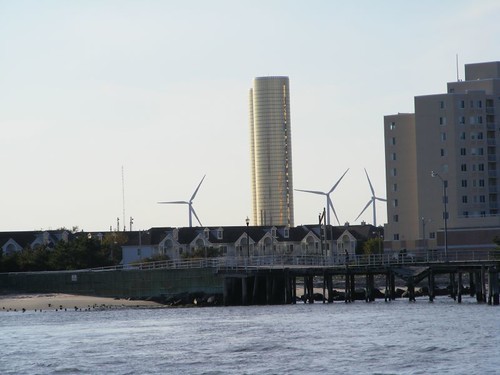
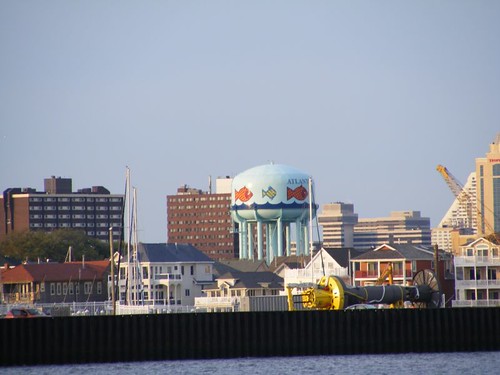
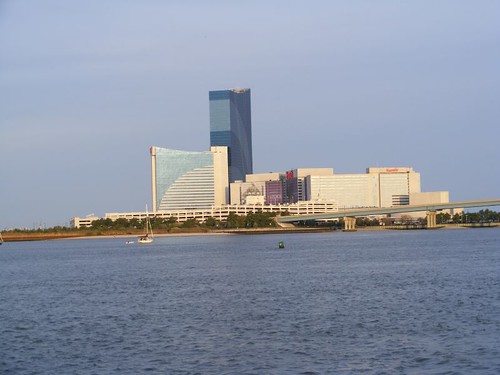

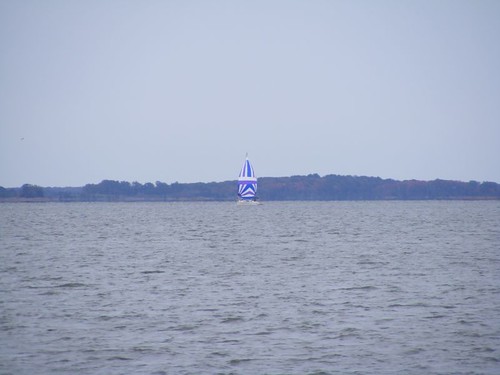
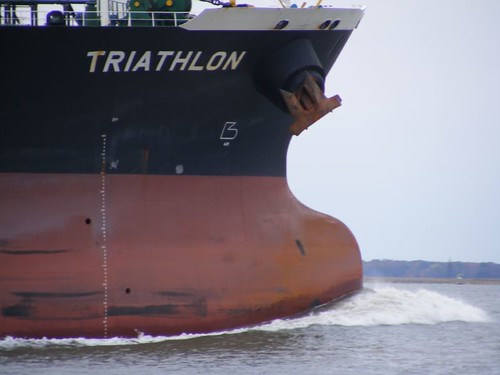
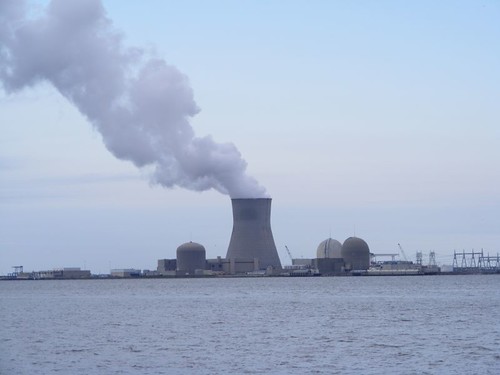








0 comments:
Post a Comment